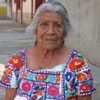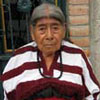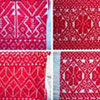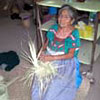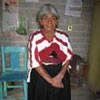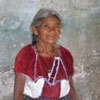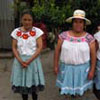|
|||||||||
|
|||||||||
|
The Tehuacán Valley begins 150 km SE of Mexico City and extends for 100 km through southern Puebla State to the Oaxaca border. This wide rift valley of cactus-studded, rolling plains has been home to indigenous people for at least 12,000 years. The mountains of the Sierra de Zapotitlán border the valley on the west. To the east, the Sierra Negra (also called the Sierra de Zongolica) creates a rain shadow that gives the valley its arid, hot climate. The first human inhabitants of the valley were wandering hunters and gatherers. About 1,000 years ago the Chocho-Popoloca speaking people who controlled the valley began to be pushed south by Náhuatl speaking migrants from central Mexico. The valley was incorporated into the Aztec Empire shortly before the Spanish conquest of Mexico. Today, over 200,000 indigenous people belonging to several ethnic groups live in the valley. Most are Nahuas, speakers of various dialects of Náhuatl, the most widely spoken indigenous language in Mexico. During the 1960's archaeologists conducted an extensive survey of the valley, locating more than 500 early habitation sites. Many sites contained evidence of farming dating back almost 6,000 years. Beans, chiles, gourds, squashes, avocados, cassava, guavas, and 15 races of maize were among the crops grown by these ancient agriculturalists. Indigenous people have irrigated the dry lands of the valley for the past 2,000 years. Today, the valley's land is irrigated and farmed intensively, but not by Nahua subsistence farmers. Rather, agri-business companies grow cash crops like sugarcane. They also raise vast numbers of goats and chickens. In 1962-63 the Cordrys visited Nahua communities in the valley and documented the clothing worn by local men and women in Miahuatlán, Zinacatepec, and Altepexi. The Cordrys noted that traditional male costumes were virtually extinct. Only the oldest women still wore huipils; blouse styles were changing; and women and girls were also abandoning traditional dress. But, the production of clothing continued in the valley. One Nahua town, San Gabriel Chilac, has had a thriving business making blouses and dresses embroidered with colorful flowers. These are sold to dealers who resell them in many regions of Mexico from Veracruz to Oaxaca to Mexico City. Today, however, textile production takes place on a giant scale. Over 300 clothing assembly plants (called maquiladoras in Spanish) are located in or near the city of Tehuacán. These "maquilas" turn out about 5 million pairs of jeans per month for the US market. Over 35,000 people are engaged in the production of jeans. Most -- around 80% -- are indigenous people ( Nahuas, Mazatecs, Mixtecs, and Popolocas). The Tehuacán Valley was once known throughout Mexico for its pure water. Now, water in the valley is contaminated by run-off from washing the maquila blue jeans and also from intensive agriculture and animal husbandry. Mexico's federal highway 131 once connected the rural Nahua towns of the valley in a route called the "camino de la huipil" which led from the central Mexican plateau to the largely indigenous states of Oaxaca and Chiapas. Few huipils can be found in the valley today. Local residents now call Tehuacán "Maquilatitlán," the place of the "maquilas." Nahua women and men have abandoned traditional dress for tee shirts and the blue jeans the maquilas pay them a few dollars a month to manufacture.
|
|
||||||||
|
|||||||||





